
Product test
A souped-up Isetta: the Microlino’s an expensive dream of driving done differently
by Michael Restin

The Energica Eva Ribelle is fully electric and incredibly fast. After 500 kilometres, one thing is clear: electric motorbikes are here to stay.
There it is in all its bright red glory: the Energica Eva Ribelle. It's not just a textbook streetfighter; it's nothing less than the future. Because this 100% electric motorbike shows that it's not only Domino's pizza couriers who can enjoy electric bikes.
There's no doubt about it: the Energica Eva Ribelle is fun. However, electric bikes give me something totally different to petrol-powered ones – whether it's my Harley or my colleague's BMW G 310 R. Is that good? Is it bad? I've got no idea, but I want both in my life.
Before we get into the swing of things, here are some short answers to the most common questions:
Climbing onto the bike, the seat is comfortably low at a height of 79 cm. Shorter riders in particular should enjoy it because the Ribelle isn't only low; it's narrow too. You can comfortably squeeze the tank – which isn't really a tank – between your legs. This ensures a stable position. Energica clearly made mass appeal a priority. Because, while my Street Rod is also around 79 cm in height, it's much wider. This makes it difficult for my 160 cm tall colleague to sit on it and have a sturdy stance. It's less of an issue on Streetfighters because they're low and narrow.
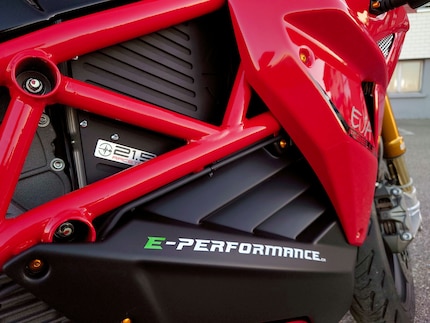
When you sit on it for the first time, you realise that this is something very different from what you're used to as a biker. Although the Ribelle is short and slender, it feels bulky and strong. That's, in part, thanks to it weighing 265 kg. That's heavy for such a small bike. But the weight is so well distributed when driving that you easily get that racing feel.
Yes, you'll tend to like riding the electric motorbike too fast.
The Ribelle is essentially a Ducati Monster-style steel frame, 330 mm Brembo brakes and an Öhlins suspension strapped to a battery in a classic streetfighter build. Then there's just the motor to add, and there you have the 145-PS electric machine. So, you have 145 PS on 265 kg. That's a lot. That's good. Very good, even. For comparison, let's look purely at the physical format of the bike. The Kawasaki Z650, for example, only weighs 187 kg with a similar seat height and width, but it has just 68 horsepower in return. Lots of weight, lots of power. And because the Ribelle is an electric machine, it thrusts all of this performance directly and instantaneously into the road.
The machine has four riding modes: Urban, Rain, Eco and Sport. Three of those simply exist; Sport is the one you actually want. Always. Except maybe when it rains. I didn't try that out – I just tested the bike at an outside temperature of over 30 degrees.
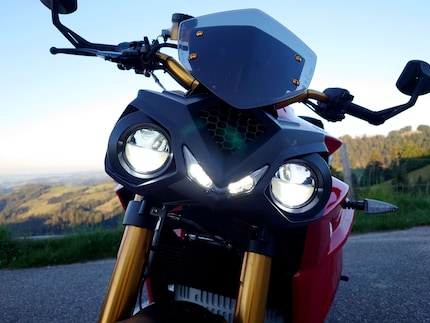
In terms of its look, the Ribelle doesn't do much new. The spartan scaffolding-style frame looks a lot like Ducati. The front resembles a Yamaha MT-10 or a robot from a Transformers film. Despite all the derivative design decisions, the end result is harmonious and looks suitably mean. Combined with the lack of engine noise, it draws a lot of attention to itself.
If you opt for a ride on the Energica, you'll need about 200 metres to get used to it. Your first reflex when you reach for the handlebar is to grab the clutch. Except there's no clutch. There's also no gearshift near your left foot. The Ribelle has two gears: forward – which leaves you wondering how fast it can go – and reverse – but only with 2.8 km/h as a parking aid. The times when you had to think twice about parking downhill in case you needed to reverse back out are finally over.
I press down the front brake and the start button. A small symbol lights up next to the display; an arrow pointing up with the word «Go» underneath. The motor is sharp. When I turn the throttle, the Ribelle doesn't ask twice or need to build up any power. It just drives off. So be careful; it's better to turn the motor off one too many times than to risk unintentionally lurching forward.
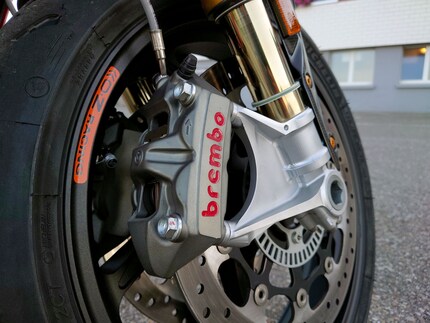
You need to constantly keep your hand on the throttle. There's no more elegant gliding on the clutch or working with the engine brake. Or riding hands-free in high gears, which you should obviously never, ever do. I never do that either. Obviously.
This is why the first few metres are a bit bumpy. The Ribelle is fast and stable above 4 km/h, but it has to earn your trust over the first few metres. Exactly like when you drive a Tesla. Somehow, everything feels different. The acceleration is quicker, the sound is different and you lose power faster.
One thing's for sure, though: the Ribelle is fun right from the start. Because when the discovery and settling-in phase is over, you can get up to a heck of a lot of mischief together. And by «mischief» I obviously mean «safe, stylish, conscious riding». Obviously.
Streetfighters are small, aggressive and agile. The high handlebars are actually built in so that you can do better wheelies. Well, you could. But it’s illegal. So, I obviously didn't try it out on the Ribelle. I wouldn’t. Mainly because the Ribelle also has built-in traction control. And that's a good thing. Because if you pass a normal two-lane junction at full acceleration, you'll be on the other side at 70 km/h. At that point, the display will throw up a warning that your «front wheel has dangerously low road contact», which generally means that it has momentarily lifted despite the traction control.
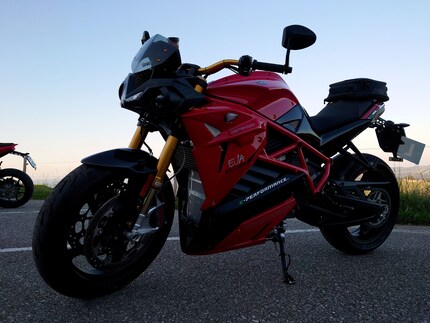
In other words, you're quicker than virtually any other traffic on the road. It never gets boring, even if your neck may eventually start to hurt.
The Ribelle is agile, so it’s light and dynamic around even tight corners. The low centre of gravity enables you to be really compact and take up very little space in the city. You can whip around quickly with a big smile on your face.
But the low centre of gravity really shows its power on winding roads. That's where the Schlieremer Wald – officially known as «Uitikonerstrasse» – comes in. Bikers know it as one of the best curvy roads nearby for an after work spin. The five bends offer virtually everything there is. And the Ribelle flies through them all. You can really lean in, provided you manage your throttle cleanly. Because the lack of clutch means adapting your cornering technique slightly. Off the throttle before the bend, but not too much, then hold it continually around the curve and then hit the gas as soon as you see the end of it. With a bit of practice, you can take the bends in the Schlieremer Wald at speeds between 70 and 80. With the lack of delay, the whole thing feels smooth and flowing.
Thundering up passes – without the thunder, understandably, because the Ribelle has an electric whine – is also pretty impressive. The direct power will easily get you up the mountain to Ahorn Alp restaurant at 60 km/h. A nice side note: as I rode back down the mountain at dusk, a deer strayed into the road. I didn’t get too close to it, but I wouldn't have even caught it in the headlights on my Harley. What an experience.
I had the privilege of calling the Ribelle my own for two days. I had one eye on the battery display the entire time. I could zoom around urban areas forever, but it was more worrying out of town and I could see the battery draining in front of my eyes on the motorway. In spite of everything, Energica claims a range of 400 kilometres in the city, 230 kilometres in mixed urban and rural areas and 180 kilometres overland. After two days, I translated my usage and worked out an average of 250 kilometres per charge.
That's absolutely fine for most uses, even when I get just as worried about my phone and would ideally charge it at 40% battery. So, I'd be much more comfortable emotionally if there were more chargers in the area. Especially outside of central Zurich because, from experience, it's somewhat harder to find a charger in my native eastern Switzerland.
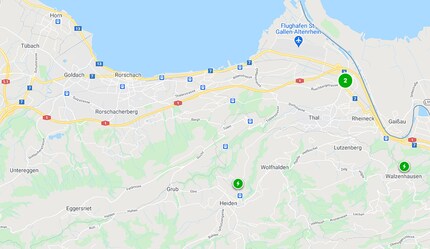
Rorschach is completely charger-free. There's one next to the old police station in Buriet, opposite the former Disco Arena which is now a Migros. Otherwise you'd have to go to Walzenhausen or St. Gallen.
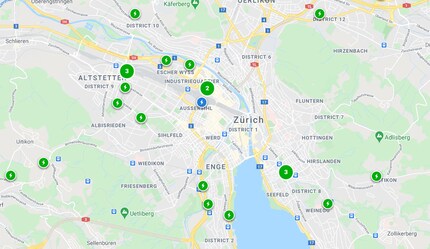
Zurich is the total opposite. Chargers abound. If the charger under Digitec HQ is in use, I can head over the bridge to Socar in Altstetten. Or use the charger at Mobility Tesla behind that. Or anywhere else for that matter. It's reassuring, even if there's no reason for it. Because it's around 97 kilometres from my office to Rorschach via the motorway, which is around 50% of the battery according to the manufacturer. Easy. But it still weighs on my mind.
Maybe it wouldn’t if I could have the bike for longer than a weekend – if I had the time to get to know and trust it. Until then, I demand that the world gets its act together and installs more chargers.
The bike itself is completely developed. Sure, a future version will hopefully travel more kilometres. And I might be tempted to say that «faster» would be better too. But the Ribelle makes a finished, solid impression overall. Then there's the optional app, which currently seems to be in its early stages but offers huge possibilities. Remote maintenance, battery status and providing information on the bike's display. Then there's navigation data, for example, or telling you who's calling.
But all of that is a long way off for Energica. The Bluetooth functions are annoyingly limited at the moment, and you don't actually need the app for a normal ride over passes and on roads. It doesn't offer any real added value yet, but that doesn't mean it won’t in the future.
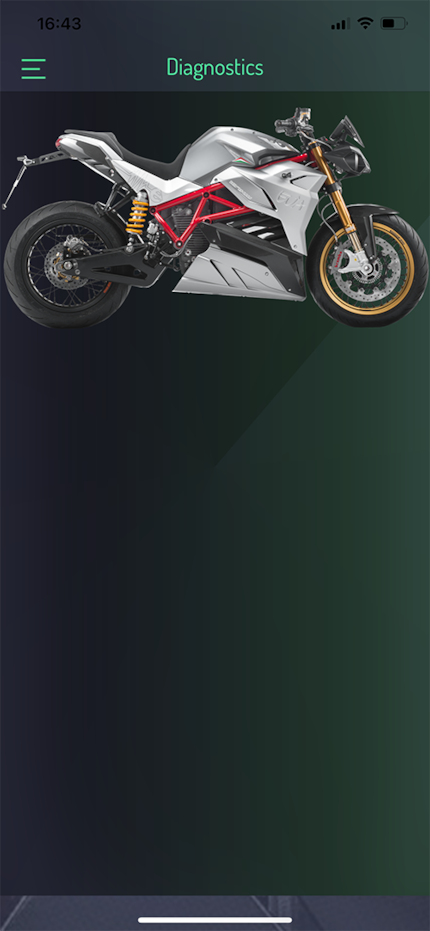
If the encryption works, there's nothing standing in the way of remote maintenance. Because electric motors are generally lower maintenance than petrol ones, thanks to having fewer mechanical parts. Many of them can be controlled electronically. It could save you a trip to the garage, but it also takes work away from said garage. But imagine: a fuse blows, or whatever. You run a diagnostics programme somewhere in the cloud, the Ribelle communicates with the app, which communicates with the diagnostics, and the error is identified and fixed. You go home and everything's fine. Great, right?
However, the wonderbike isn't without its issues. Generally, you tend to go too fast more often than too slow. There are two reasons for this:
The Ribelle isn't silent. It's way quieter than my Harley or even a BMW G 310 R, which hardly makes a noise at low revs. But it does buzz. Over time, you can use this buzzing to work out roughly how fast you're going based on the volume, pitch and wind. But it takes practice and time.
Until you've got this exercise down, you might go full throttle, brake again, maybe test the regenerative braking – spoiler alert: at the end of your descent, you'll have a bit more battery than you did at the top. Then you might take a quick trip to your local Migros or to a friend's house, raving: «Go for a ride, you need to experience this!»
You'll get sore muscles on your right-hand side. And you don't have the chance to shake your hand or take it off the handlebars for a break. Because you lose speed as soon as you let go of the throttle. Energica tries to solve this with cruise control.
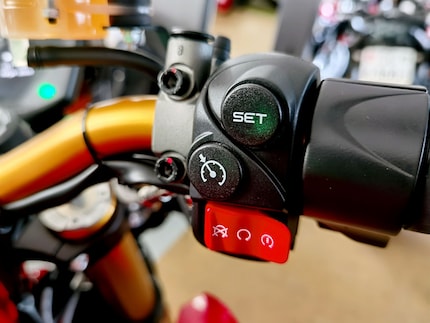
What a completely weird feeling.
Your bike just keeps going. Constantly, effortlessly, quietly. As the rider, you don't need to do anything. Nothing at all. You sit there and let yourself be carried, seeing as you'll only use cruise control on long straights. And if you're not feeling like you're flying by this point, it'll definitely come when you ride with cruise control.
My arms lift up almost by themselves. I want to feel the moment. This nothingness in between moments. Me. The wind. I’m almost tempted to close my eyes. And even if you only ride two kilometres on the Energica, try it out if you feel safe enough. It's worth it. A wish for the next model: I'd have liked the button to activate the cruise control to be about five millimetres further to the right. I had to really stretch to reach it with my thumb.
Earlier in this article, I answered the questions I'm asked the most. But I should also mention that the rear brake is extremely sensitive. You’re better off leaving your right foot off the pedal entirely. This is generally followed by the question: «Will you be changing your bike?» In other words, will I be leaving my Harley to quietly gather dust, or will I stick with it?
I don't really see why I should only be able to have one or the other. The price would probably determine that, but then you'd side with the gas guzzler. The Energica isn't cheap, but everyone enjoys it. No noise for the neighbours, no exhaust fumes for the environment and no fuel costs for you. And all of that with speed.
But the Energica didn't give me the same feeling as my Harley does. The Ribelle is brash, commanding and forward-looking. How could it not be, when the electric motor asks, «What? Is that it? Come on, I can do more,» at 160 km/h? How could this raw performance not be the future? The battery technology might improve, or the motors might get better. But, in general, Energica is one of the brands that have identified why electric motorbikes are cool.
In contrast, my Harley with its V-twin gives me peace of mind, relaxation and rhythm. It has power, but you have to coax it out. Otherwise, it peacefully chugs along with you, gets on your neighbours' nerves and is fuelled by dinosaur juice.
However, the idea of an electric bike is just too good to say, «No, not me. Never.» So, my advice is: if you get the chance, climb onto the saddle of an Energica. You'll definitely have fun.
Journalist. Author. Hacker. A storyteller searching for boundaries, secrets and taboos – putting the world to paper. Not because I can but because I can’t not.